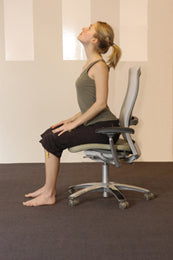Be kind to your spine
Did you know that the average office worker will sit at their desk for more than 60,000 hours during their professional life? This is not inclusive of the countless hours spent sitting at a desk during school years, watching television, or even driving a car. At work, back problems can be caused by poor posture while sitting and by not taking enough breaks. Hours of sitting with poor posture increases the risk of serious injury and back pain over time, and is currently costing Australians millions of dollars annually.
So what can you do?
Practical ergonomics is about changing repetitive behaviours that put continued and sustained stress on parts of your body. It’s about taking short breaks from your work to refresh and relax. Applying practical ergonomics is simple and will help reduce the risk of office related back and spinal problems. Firstly, ensure that your basic ergonomic setup is correct by following our simple workstation setup guide. With a range of fully adjustable office furniture, Ergonomics Now can help you find the chair or desk that offers the best support and comfort for your back while working. it is important to take regular breaks away from your chair. Get up at least every half hour to file, photocopy, or to just walk across the office and back. Innovative software such as RSI Guard uses pop up messages with animated stretches on your computer to remind you when and how to stretch depending on your behaviour at the computer. Stretch Cards and Posters are also a good way to display stretches and diagrams near your workstation. There are exercises specially designed to stretch, release tension, open the chest and promote better circulation. These are easy to do while seated near your computer and take just a few minutes each:
Forward Bend
Benefits: Releases tension in the lower back, elongates the spine.
Step 1: Sit comfortably on the chair, feet parallel and resting on the floor. Place hands on the knees, elongate the spine and the back of the neck.
Step 2: Bend forward from the hips, leading with the front of the body. Release hands onto the floor, resting the chest on the knees.
Step 3: Hold for 10 seconds, then gently come up.
Spinal Twist
Benefits: Stretches the muscles of the spinal column relieving tension or tightness, nourishes the spinal nerves, opens the chest.
Step1: Sit on a chair, your weight slightly forwards. Do not collapse the back of your waist but sit up tall, so that the front of your body is stretched and your chest is open.
Step 2: Then, without moving your hips, twist to the right and hold the back of the chair seat with your right hand, putting the back of your left hand against your right thigh. Keep your knees in line with your hips. As you turn, drop your shoulders, letting your spine stretch up from the hips. Hold for 30 seconds, relax and repeat on the other side.
Seated Spinal Stretch
Benefits: Increases mobility of the hips and lower back. Opens the chest, promotes breathing and better circulation.
Step 1: Sit on front of chair, feet parallel & flat on floor. Allow the spine to lengthen.
Step 2: Place your hands on your knees.
Step 3: Inhale as you draw your shoulders back.
Step 4: Lift your head and draw your heart forward and up, arching your back.
Step 5: Exhale, release your head down. Press your hands into your knees, round your back up toward the ceiling. Draw the abdominals in towards the spine.
Step 6: Repeat 4-5 times, then come back to a sitting position.
|









